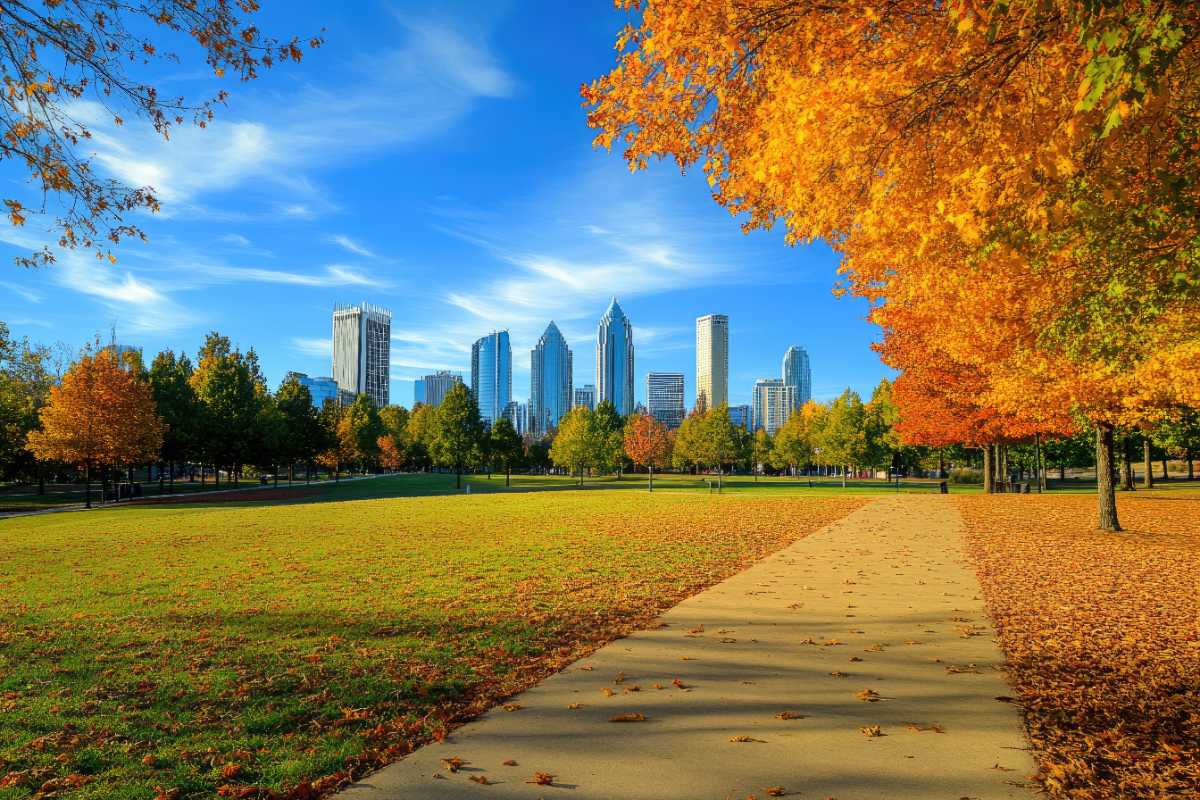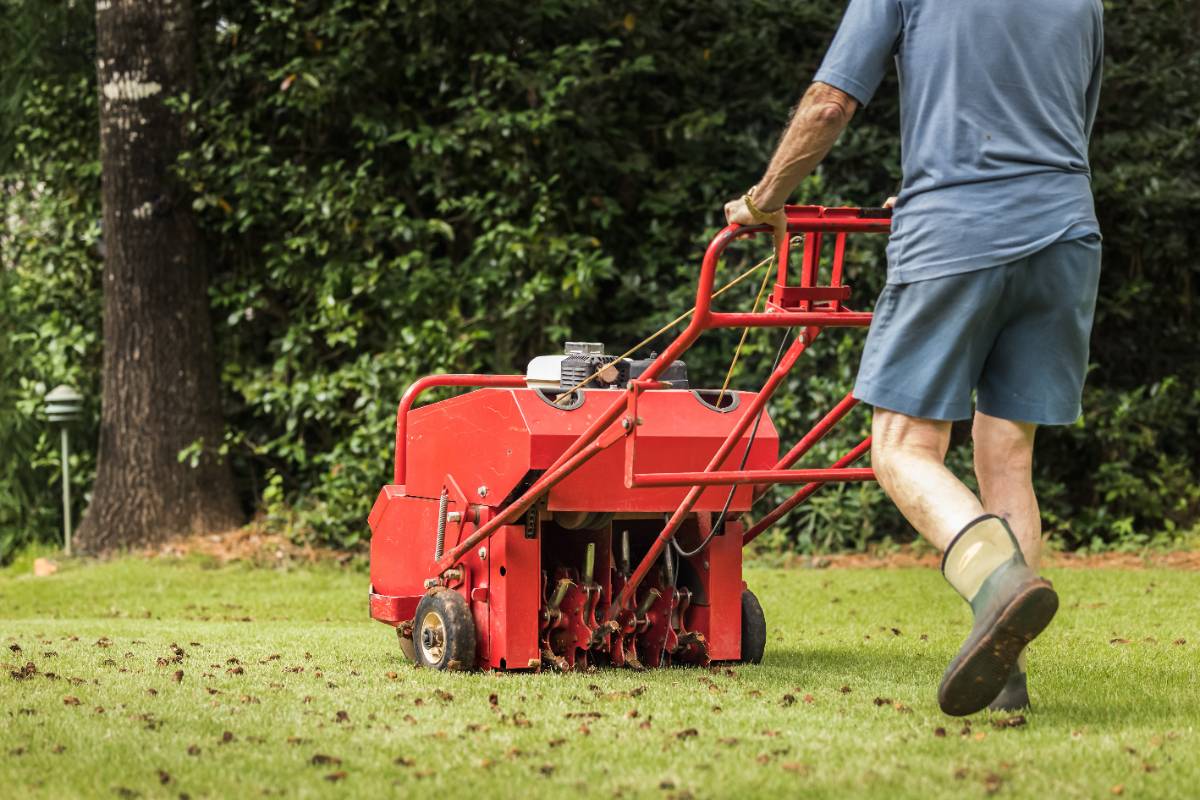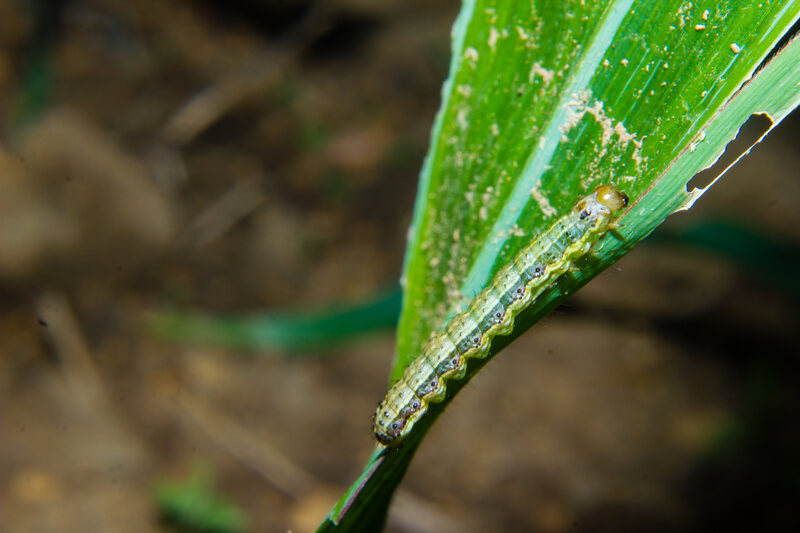
Fall lawn care here in Charlotte focuses on cleanup, soil prep, and turf maintenance. Fallen leaves, cooler nights, and active root growth make it the ideal time to support your lawn.
These are the fall lawn care tips for Charlotte I follow to prep my yard for winter. I’ll walk you through what to tackle between September and November to ensure your yard is healthy year-round.
- 1. Stay Ahead of Falling Leaves
- 2. Adjust Your Mowing Height Gradually
- 3. Aerate Your Lawn Before the First Frost
- 4. Overseed Thinning Areas
- 5. Fertilize for Stronger Roots
- 6. Water Properly for the Coming Winter
- 7. Block Winter Weeds the Natural Way
- 8. Spot Pests and Disease Early
- 9. Winter-Proof Your Irrigation System
- 10. Clean Up Garden Beds and Lawn Edges
1. Stay Ahead of Falling Leaves
Removing leaves is my biggest and most constant fall chore as a Charlotte homeowner. As you know, if you wait too long to rake, layers of wet leaves build up quickly, block sunlight, and trap moisture. This can suffocate your grass and invite lawn fungus.
Shaded areas under trees, near fences, or beside buildings dry out more slowly and need extra attention. Low spots and depressions in your lawn are also prime spots for soggy leaf buildup and fungal growth.
Here’s what I do: I rake weekly, but not everywhere. I make sure to set aside a few spots, like the bases of my trees and the lower part of my yard that isn’t grassed in, to pile leaves. That way, my lawn-free zones, tree roots, and garden beds stay protected from the cold. Plus, the local critters have a place to hunker down for winter.
| Quick Fall Leaf Removal Tips |
| • Rake weekly or use a mulching mower if the leaf layer is thin. • Pay special attention to any shaded, low-lying, or hard-to-see areas where leaves can build up undetected. • Compost, bag, or bin leaves depending on your neighborhood’s pickup rules; my area picks up lawn bags and dumps bins once a week. |
2. Adjust Your Mowing Height Gradually
Don’t park your mower in the garage too early. Despite appearances, tall fescue, the most common cool-season grass in Charlotte, continues to grow and build roots through most of fall. Keep mowing weekly and lower your mower blade slightly each mow. By late October, aim for a final mow at 2 to 2.5 inches.
Having a shorter lawn going into winter allows more sunlight to reach the crown of the grass and helps prevent disease while keeping your lawn from matting under leaves or frost. The gradual lowering of your mower blade helps reduce turf stress.
| Top Fall Mowing Tips |
| • Avoid mowing cool-season lawns like fescue too low • Keep your mower blade sharp and lower it gradually • Make your final mow before the first frost. In Charlotte, this is around the end of October |
3. Aerate Your Lawn Before the First Frost

After a hot summer filled with higher foot traffic and mower passes, your soil is likely compacted. Aerating your lawn in the fall opens up the soil, letting air, water, and nutrients reach the roots before your grass goes dormant for the winter.
If you plan to overseed or fertilize, aerate first. It helps seed-to-soil contact and improves nutrient absorption.
| Best Aeration Tips for Fall |
| • Use a core aerator (not spike), which pulls out small plugs of soil • Water the lawn the day before for smoother aeration • Aerate before the first frost (mid-September to late October in Charlotte) |
4. Overseed Thinning Areas
If your lawn is mostly tall fescue or Kentucky bluegrass, fall is the ideal time to overseed. It helps thicken turf, crowd out weeds, and repair sun and foot traffic damage from the summer months. Overseeding is a straightforward, cost-effective method that doesn’t require tearing up your yard to get noticeable results and a greener lawn come springtime.
Homeowners with Bermuda or Zoysia lawns (warm-season grasses) should skip overseeding unless they are applying annual ryegrass for winter color, so the grass remains green even in winter.
| Overseeding Fall Lawn Quick Tips |
| • Overseed right after aerating to help seeds reach the soil • Use a handheld or broadcast spreader for more even coverage • Water lightly once or twice a day for 10 to 14 days • For bare patches, apply a lawn patch mix with seed, mulch, and fertilizer included |
5. Fertilize for Stronger Roots

The best time to fertilize cool-season grass is mid-to-late October, when top growth slows but grass roots are still active underground. Try to fertilize while soil temperatures are above 50°F to avoid nutrient runoff and reduced root absorption. Use a winterizing formula as part of your winter yard preparation for best results.
| Top Fall Season Grass Fertilizer Tips |
| • Use a slow-release fertilizer high in nitrogen • Apply two to three weeks after seeding, so you don’t stress new grass • Water it lightly to activate it and prevent runoff • Avoid fertilizing warm-season grasses, which are headed into dormancy |
6. Water Properly for the Coming Winter
During the cooler fall temperatures, your lawn still needs about one inch of water per week, especially if you’ve overseeded or fertilized it. A consistent moisture level supports root development and helps new seeds take hold.
Rainfall in Charlotte in the fall can vary; adjust your weekly watering accordingly. Too little water leads to shallow roots, while overwatering can promote rot or fungal disease.
| Top Lawn Watering Tips for Fall |
| • Water deeply once or twice a week if there’s no rain • Any newly seeded areas need light watering once or twice a day for the first 10 to 14 days • Water in the morning to avoid evaporation, let water soak in, and reduce the chance of fungus |
7. Block Winter Weeds the Natural Way
In the Queen City, warm-season lawn grasses like Bermuda and Zoysia need support to hold back colder-weather weeds that tend to pop up in the fall. Those can include henbit, crabgrass, clover, and annual bluegrass. While commercial weedkillers are available, if you’re avoiding synthetic herbicides, you still have solid options for weed control.
| Best Cold-Season Weed Prevention Tips |
| • Pull any visible weeds by hand before they go to seed • Maintain healthy soil and turf density to crowd out invaders • Most winter weeds start along borders and bare spots; keep your lawn edges and thin areas clean. • Carefully apply a corn gluten-based natural pre-emergent around mid-September for a chemical-free weed barrier • Combat weeds, head-on, by skillfully applying boiling water or white vinegar on weed crowns and leaves; avoid grass and—of course—your skin |
8. Spot Pests and Disease Early

Cooler weather doesn’t stop pest activity or disease spread. In Charlotte, lawn enemies often show up after a stretch of rain or deep watering, even as temperatures drop.
Fall armyworms are the most common culprit and are voracious. They can strip large patches of grass virtually overnight if not caught early. Grubs, fungal issues, and chinch bugs can also pose a threat to the health of your lawn.
Spotting pests is the first step to stopping damage; once identified, you can adjust your watering, improve drainage, apply treatments, and rake out problem areas to disrupt their habitat. Keeping the lawn healthy and monitored is often enough to stop a small problem from becoming a large one.
| Great Pest Prevention Tips for Fall |
| • Look for chew damage on blades, brown patches, or thin spots in your lawn • Improve drainage and reduce thatch (matting and debris), to help prevent fungi like brown spot • Clean mower blades between uses to avoid spreading spores or pests • Perform a soap flush test on damaged areas to help identify insects and rule out climate/weather as the culprit |
9. Winter-Proof Your Irrigation System
Freezing winter nights in Charlotte can crack sprinkler lines and valves if your lawn irrigation system isn’t drained properly in the fall. Removing water from and winterizing your sprinkler system helps prevent costly repairs and preps your system for a low-hassle restart in spring. Aim to tackle this task before Charlotte’s first hard freeze, which usually happens near the end of October.
| Top Winterization Tips to Keep Your Sprinklers Safe |
| • Shut off the water supply and timer to your irrigation system • Open drain valves and use compressed air to blow out any remaining water in the lines • Insulate above-ground parts, including any exposed valves; foam insulation is sufficient • If you have a complex system, consider hiring a professional to prevent the need for costly repairs come spring |
10. Clean Up Garden Beds and Lawn Edges
Thoroughly cleaning up your lawn in the fall helps protect it during the winter months and gives you a head start for spring, as it will warm up faster. Clearing leaves, trimming lawn borders, and mulching your garden beds help your yard breathe and cut down on the number of hiding places for pests. It also feeds the soil with organic matter.
Fall is also a great time to walk around your property and inspect for drainage issues or compacted areas that may require attention before spring. Taking time to manage these issues before another winter sets in means you’ll be well prepared for springtime necessities and not scrambling to catch up
| Best Fall Lawn Cleanup Tips |
| • Rake and remove leaves from turf, flower beds, and gutter lines • Create free and organic mulch; shred or compost your leaves • Edge your lawn borders with a flat spade or edging tool • Add a 3-inch layer of pine straw or wood chips to garden beds • Inspect low spots and drainage areas and fix any standing-water issues |
Following these top ten lawn care tips goes a long way to making sure your lawn is taken care of during Charlotte’s colder weather months and comes back a vibrant green in the spring.
Let Lawnstarter’s Experts Take Care of Your Fall Prep

If you’d rather spend your fall weekends watching football or sipping hot cocoa around your backyard fire pit on a cooler evening instead of raking leaves, adjusting mower heights, or battling winter weeds, LawnStarter can help.
LawnStarter’s Charlotte-area lawn care pros handle everything from mowing and edging to leaf removal and seasonal prep so you can take time to relax while your lawn stays healthy and clean.
Lawnstarter experts serve homeowners across the Charlotte metro area, including Concord, Matthews, Huntersville, and more. Book a pro with a tap in our app, online, or by phone and take one more thing off your fall to-do list.
Main Image: Downtown Charlotte during fall at Marshall Park. Photo Credit: Serhii / Adobe Stock